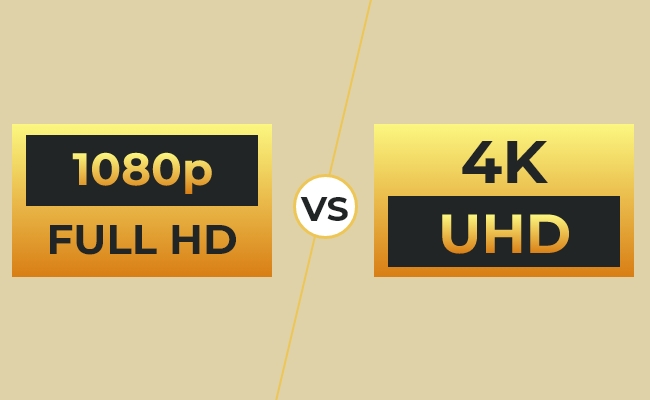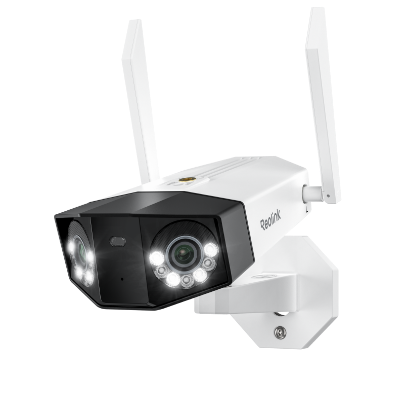UHD vs. FHD:What's Difference between Them?

We all understand that display resolutions are key in our visual experiences. However, when it's about UHD and FHD, the difference between UHD and FHD may not be apparent quickly.
In this blog post, we will help you learn UHD vs. FHD to help you understand things better. It will certainly let you make better decisions regarding your visual devices.
What is FHD?
Let's have a look at the detailed overview of FHD meaning to learn more:
What does FHD mean?
FHD means Full High Definition, also known as Full HD or 1080p. It is a display resolution commonly used in TVs, monitors, laptops, and other devices. It provides a resolution of 1920 x 1080 pixels, which means there are 1920 pixels horizontally and 1080 pixels vertically on the screen. This resolution offers a detailed image with greater pixel density compared to standard HD displays.
Pros of FHD
Here, we have enlisted some key advantages of FHD resolution:
1. Sharp and detailed image
FHD provides a high level of detail and clarity, allowing for a visually pleasing viewing experience. The increased pixel density ensures that images and videos appear sharp and well-defined.
2. Wide availability
FHD displays are widely available and can be found in various devices, including TVs, monitors, laptops, and smartphones. It makes it easier to find content optimized for FHD resolution.
3. Cost-effective
FHD displays are generally more affordable compared to higher-resolution options like 4K or 8K. It makes FHD popular for consumers who want a good balance between price and image quality.
4. Compatibility
FHD content is widely supported across various platforms and devices. It is the standard resolution for Blu-ray discs, streaming services, and most video content. FHD displays can also upscale lower-resolution content, ensuring compatibility with a wide range of media.
5. Energy efficiency
FHD displays consume less power compared to higher-resolution displays like 4K or 8K. It can result in longer battery life for laptops and smartphones.
Cons of FHD
Here we have the cons of FHD enlisted below:
1. Less immersive experience
Due to the lower pixel density, FHD may not provide the same level of immersion and visual impact as higher-resolution displays. It can be particularly noticeable when viewing content on larger screens.
2. Limited future-proofing
As technology advances, higher-resolution displays like 4K and 8K are becoming more prevalent. While FHD is still widely used, it may become less common as higher-resolution options become more affordable and accessible.
3. Less detail for professional use
FHD may not offer enough detail for certain professional applications, such as video editing or graphic design, where precise image quality and pixel accuracy are crucial. In these cases, higher-resolution displays are often preferred.
What is UHD?
Let's have a look at the in-depth detail of what is UHD to learn more:
What does UHD mean?
UHD means Ultra High Definition. It also refers to a display resolution that surpasses the traditional High Definition (HD) resolution. It offers a higher pixel count, resulting in a more detailed and vibrant visual experience. While HD typically encompasses a resolution of 1920x1080 pixels, UHD takes the visual experience to the next level by offering a resolution of 3840 x 2160 pixels. Remember that 4K and UHD are not the same.
Pros of UHD
Let's have a look at the pros of UHD:
1. Enhanced visual experience
UHD offers a level of visual quality unmatched by previous display technologies. The increased resolution provides a more immersive and life like experience, making UHD ideal for gaming, watching movies, and viewing high-quality photographs.
2. Future-proof investment
As UHD continues to gain popularity, more content is being created and optimized for this resolution. By investing in UHD, you are future-proofing your entertainment setup, ensuring compatibility with upcoming media and devices.
3. Improved accessibility
UHD displays have become more affordable and accessible in recent years, allowing a broader range of consumers to enjoy the benefits of this technology. With the growing number of UHD content options, consumers can now experience UHD without breaking the bank.
4. Greater detail and clarity
UHD's higher pixel count results in finer details and sharper images. This increased resolution brings out the intricacies in visuals, allowing viewers to see more depth and texture in the content they are consuming.
5. Increased screen real estate
UHD's higher resolution allows for more screen real estate, enabling users to fit more content on the screen without sacrificing clarity. This can be particularly useful for professionals who require multiple windows or applications open simultaneously.
Cons of UHD
Here we have the cons of UHD to know:
1. Limited content availability
While the availability of UHD content is increasing, it still falls short compared to HD content. Many streaming platforms are gradually expanding their UHD libraries, but it may take some time before UHD becomes the norm. However, this limitation is expected to diminish as UHD gains traction.
2. Bandwidth and storage requirements
UHD content typically requires a higher bandwidth for streaming and significant storage space for local playback. It can pose challenges for users with limited internet connectivity or storage capacity, as it may result in longer buffering times or the need for additional storage devices.
3. Upgraded hardware
In order to fully enjoy the benefits of UHD, users may need to invest in compatible hardware. It includes UHD-capable televisions, monitors, and devices that support the required HDMI or DisplayPort standards. Upgrading to UHD may involve additional costs, especially for those already owning HD equipment.
UHD vs FHD: What are the Differences?
UHD, also known as 4K resolution, features a stunning resolution of 3840x2160 pixels. FHD, commonly called 1080p, offers a resolution of 1920x1080 pixels. Although not as high as UHD, FHD still provides a crisp and clear display.
Let's have a look at the quick comparison table for the difference between UHD and FHD (also know 4K vs. 1080p):
UHD vs. FHD: Which One to Choose?
When choosing between FHD and UHD, it's important to consider your specific needs and preferences. Here's a comparison of FHD and UHD in different contexts:
FHD vs. UHD TV
UHD TVs offer a higher pixel density, resulting in a sharper and more detailed image compared to FHD TVs. UHD TVs are ideal for larger screens, as the higher resolution allows you to sit closer to the TV without sacrificing picture quality.
In contrast, FHD TVs are more affordable than UHD TVs, making them a popular choice for those on a budget.
FHD vs. UHD monitor
UHD monitors provide a higher level of detail and sharpness due to their increased pixel density compared to FHD monitors.
UHD monitors are well-suited for tasks that require precise image quality, such as video editing or graphic design, where every detail matters.
However, FHD monitors are more affordable. Therefore, these are a popular choice for everyday use and general computing tasks.
FHD vs. UHD phone camera
UHD phone cameras are particularly beneficial when capturing high-resolution photos or recording videos that require greater detail, such as vlogs or professional content creation.
In contrast, FHD phone cameras can still capture good-quality photos and videos. Additionally, they are often more power-efficient compared to UHD phone cameras.
FHD vs. UHD security camera
FHD cameras are more budget-friendly compared to UHD cameras.
They are suitable for scenarios where high-quality images with vivid details from a moderate distance are required. Typical scenarios for FHD security cameras include entrances to homes, garages, driveways, small businesses, and construction sites.
In contrast, a UHD security camera is recommended when the highest resolution of video quality is required or when you need to monitor large areas with a single surveillance camera.
Typical scenarios for UHD security cameras include commercial spaces like shops, bars, restaurants, warehouses, and locations where future-proof video surveillance is necessary.
FHD vs QHD vs UHD: Which is Better?
When choosing between FHD, QHD, and UHD resolutions, it's important to consider your specific needs and use cases. Here is FHD vs. QHD vs UHD you need to know:
-
FHD is a cost-effective option and works well for smaller screen sizes. FHD offers good detail and clarity for everyday tasks like web browsing, watching movies, and general computer usage. For instance, if you are engaged in general writing or casual movie-watching tasks, FHD can be sufficient.
-
QHD provides a higher level of detail and sharper image quality compared to FHD. QHD is ideal for tasks with enhanced visual experience, content creation/editing, and a more immersive movie-watching experience. For example, if you are involved in content development or appreciate a more detailed display, QHD could be a good choice.
-
The entertainment industry increasingly embraces UHD for displaying 4K content at its best. UHD is recommended for gaming enthusiasts who want a visually appealing and engaging gaming experience. Additionally, if you are into high-quality video editing or want the best possible visual experience when watching movies, UHD is a strong option.
Exceeding UHD Resolution - 16MP Security Camera
A 16MP camera produces images with 16 million pixels. More megapixels mean more detail and the ability to print larger pictures without losing quality.
A 16MP camera is excellent because it captures lots of details, making your videos clear and sharp. Reolink 16MP security camera, Duo 3 PoE and Duo 3 WiFi are all good options. These cameras have a 16MP ultra-high resolution and dual lenses, covering a wide 180-degree field of view. They can connect to continuous power and offer continuous recording capabilities.
Groundbreaking 16MP Dual-Lens WiFi Camera
16MP UHD, Dual-Lens, Motion Track, 180° Wide Viewing Angle, Plug-In WiFi, Color Night Vision.
FAQs
1. Is UHD better than FHD?
UHD generally offers a higher resolution and, therefore, a sharper and more detailed image compared to FHD. In fact, UHD has four times the number of pixels as FHD, resulting in a more immersive viewing experience with finer details and crisper images.
2. Can I watch UHD on a regular TV?
You can watch UHD content on a regular TV, but only if it can display UHD content.
Devices like Apple TV 4K, Chromecast with Google TV, Roku Ultra, Amazon Fire TV Stick 4K, and Nvidia Shield are capable of streaming 4K content to your regular TV. These devices connect to your TV and provide access to various streaming services that offer 4K content.
Some smart TVs come with built-in support for 4K resolution. Smart TVs from brands like Samsung, LG, Hisense, and Sony often offer 4K capabilities. These TVs have the necessary hardware and software to stream and display 4K content directly without the need for an additional streaming device.
3. Is FHD better than UHD gaming monitor?
When it comes to gaming monitors, the choice between FHD and UHD depends on various factors, including personal preference, the hardware capabilities of your gaming system, and the types of games you play.
Conclusion
In the battle between UHD and FHD, the choice ultimately depends on your specific needs, preferences, and budget. UHD offers unparalleled image quality and detail, making it the preferred choice for individuals seeking the highest level of visual immersion. However, FHD remains a popular option for its affordability and ability to deliver clear visuals for everyday usage.
Search
Subscribe for the Latest Updates
Security insights & offers right into your inbox

